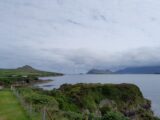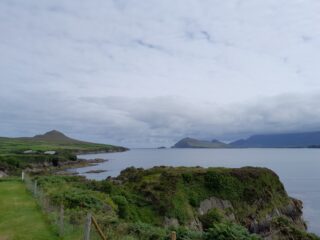Notice
Dún an Óir is a state-owned National Monument in the care of the Office of Public Works
WARNING: It should be noted that these sites are unguided and a level of care and caution should be maintained during all stages of your visit. The Office Of Public Works (OPW) will not be held responsible for any damages, injuries, or losses that occur
Dún an Óir
Dún an Óir (The Fort of Gold) was the site of one of the bloodiest events in Irish history. In November 1580, during the Second Desmond Rebellion, an 800 strong English army, under the command of Baron Arthur Grey, the Lord Deputy of Ireland, attacked and defeated the forts’ combined Spanish, Italian and Irish rebel garrison.
This headland was first used as the site for a fortress in the Iron Age between 500BC and 500AD when a promontory fort was constructed here with a series of ditches, earthen ramparts and wooden palisades on the landward side, and defended by cliffs on the other three sides. This fort may have been periodically re-used and re-occupied up to the first Norman invasion of Ireland in 1169.
The fort is best known for the events that took place here during the Second Desmond Rebellion. The Desmond Rebellions had several causes: in terms of politics, they were an attempt to achieve a measure of Irish independence from England as well as part of a wider European conflict for dominance that was being waged between the Spanish and the English. In terms of culture, they were an anti-colonial struggle pitching the native Gaelic Irish and Gaelicised-Old English families, such as the Desmonds and Fitzgeralds, against new English colonisers. Finally, in terms of religion, they were inspired by the idea of a Catholic crusade against what they saw as a heretic English monarch – namely the Protestant queen Elizabeth I.
In 1580 a combined Spanish, Italian and Irish rebel army landed at Smerwick Harbour and began constructing new, more modern, defences at the site. However, before they could complete their work they were attacked on 7th November 1580 by Grey’s army. After a three day siege, approximately 600 of the combined Spanish, Italian and Irish rebel force (including women and children) surrendered and were immediately massacred by their English captors.
The earthworks visible at the site today on the landward side are the remains of the unfinished Spanish bastion fortifications from that siege, whilst those further out on the promontory were the foundations for garrison buildings.
Protect our Past - Click here to read about the importance of protecting our country’s unique heritage sites
This national monument is protected in accordance with the National Monuments Acts 1930 to 2014
Gallery
Nearby sites to visit
Ionad an Bhlascaoid – The Blasket Centre
The story of a remarkable island community
Approx. 5.3 km from Dún an Óir
Sceilg Mhichíl UNESCO World Heritage Property
An island monastery towering over the sea
Approx. 45.0 km from Dún an Óir
Ardfert Cathedral
A trio of medieval churches devoted to St Brendan
Approx. 48.0 km from Dún an Óir


